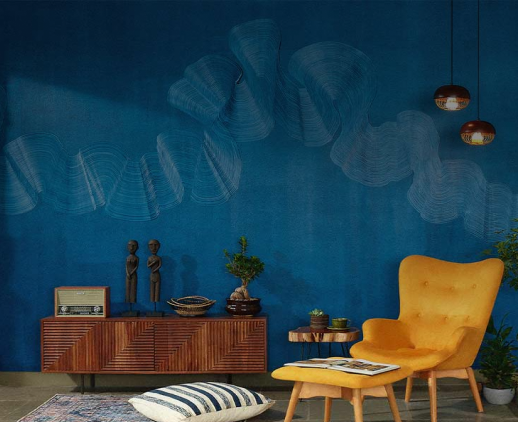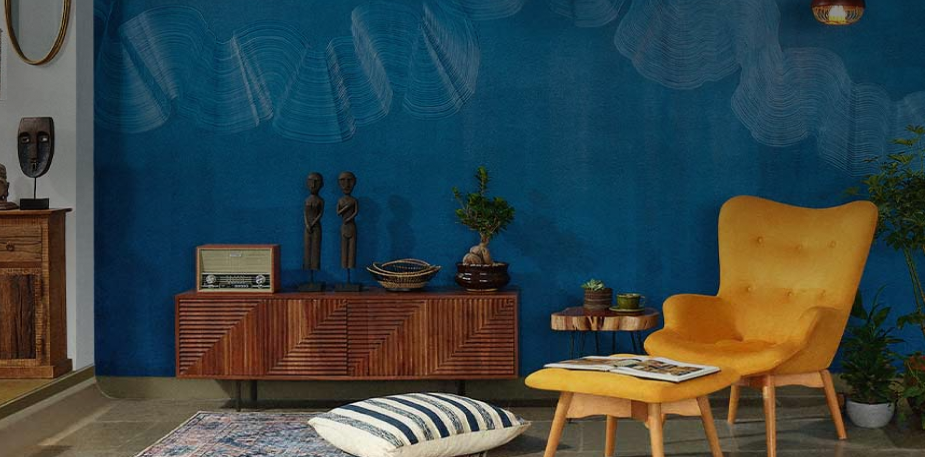Get your home interior design budget estimate
10 ways mushrooms are influencing design and pop culture

As one of the trends to look out for in the Asian Paints ColourNext 2023 forecast report, ‘Shroom’ is notable for its power to capture our imaginations. This humble but versatile fungus is making waves across every industry
From being eaten in innovative ways across different cuisines (sometimes even ingested medicinally) and being lauded for its cultivating ease in urban farming to ruling the runway with leather fashioned from its flesh and setting fire to celluloid as a subject of intriguing documentaries—the humble mushroom is having its moment across pop culture this season.
Mushrooms are On-Trend in 2023
As one of 2023’s trends to look out for in the Asian Paints ColourNext trend forecast report, ‘Shroom’ is notable for its power to capture our imaginations—emerging as the new frontier for science, art and everything in between. While mushrooms have been associated with decay and decomposition, we’ve grown to learn that these vast, interconnected spores also tell a story of revival and rebirth, taking things that are dead and turning them back to life. In many ways, it mirrors the year itself, as we bounce back from isolation after the global pandemic. The trend forecast encompasses a colour palette of creams and beiges with the occasional pink and blue to hint at the inherent grooviness and intrigue of the wild fungi.

The uneven and porous mushrooms are on trend in the Asian Paints ColourNext 2023 trend forecast report. Image courtesy, Kunal Daswani
Its uneven, porous, sometimes cracked surface has also sparked the resurgence of materials similar in texture such as glazed ceramic, pumice stone, plaster and vibrantly hued agate stone.
Here are the coolest ways in which this groovy fungus is making waves across the globe:

Perform Ground Coffee with L-Theanine & Cordyceps Mushrooms from The Wellness Collective provides the spark you need to power your most demanding days. Image courtesy, Theanine and Cordyceps
START YOUR DAY WITH MUSHROOM COFFEE
No, we’re not kidding! Lauded as a healthier alternative to regular coffee—boasting medicinal properties and added health benefits—mushroom coffee is a trending beverage that’s actually been around for many years. Initially used as a coffee substitute in Finland during World War II when coffee beans weren’t available, today, mushroom coffee is a delicate blend of ground mushrooms and coffee beans combined to make a dark, smooth, and nutty brew. Using extracts from medicinal mushrooms such as chaga, turkey’s tail, lion’s mane, reishi or cordyceps rather than culinary mushrooms like shiitake and portobello, this trendy cuppa doesn’t taste any different than your regular coffee.
However, the suggested health benefits of mushroom coffee include lowering levels of anxiety and improving immunity, while overall containing lesser amounts of caffeine with each cup.
MUSHROOMING A FILM
Lauded as a visually dazzling, thought-provoking documentary that sets out to make audiences see mushrooms differently, Fantastic Fungi is a descriptive time-lapse journey about the magical, mysterious and medicinal world of fungi and their power to heal, sustain and contribute to the regeneration of life on Earth that began 3.5 billion years ago. In the film directed by Louie Schwartzberg, a viewer gets to delve into the magical world of fungi from mushrooms that clear oil spills to underground fungal networks that help trees communicate! Combining time-lapse cinematography, computer-generated imagery (CGI), and interviews that explain the biology, environmental roles and various uses of mushrooms, the feature aims to share the beauty and intelligence of nature—starting with the magic and mystery of mushrooms—to protect the planet and create a better future.
Streaming on Netflix now

Fantastic Fungi, a film directed by Louie Schwartzberg is a descriptive time-lapse journey about the world of fungi. Image courtesy, Fantastic Fungi movie

Mega-Mushroom Relief & Resilience Fortifying Emulsion is a hydrating moisturiser by DR. Andrew Weil for Origins. Image courtesy, Origins
MUSHROOMS AND SKINCARE
With the skincare industry quickly hopping onto the shroom boom, mushrooms and their extracts have been found to benefit the skin with their metabolites that help fight free radicals, have hydrating beta-glucans and melanin-inhibiting compounds that can help combat dark spots, and high vitamin D content to keep damage at bay. Beta-glucans, triterpenes, polysaccharides, and polyphenols (all found in mushrooms) have often been used to alleviate rosacea, sensitivity, acne scarring, and compromised skin barriers. Today, drugstore brands and niche skincare labels tap into different types of mushrooms to develop products such as Kora Organics’ Milky Mushroom Gentle Cleansing Oil, Aminu’s Correcting Concentrate, The Switch Fix’s Magic Shrooms Scalp Serum, and an entire skincare line with reishi-infused treatments by Origins.
FASHIONING MUSHROOMS
From American fashion designer Brandon Maxwell being inspired by mushrooms to create colourful graphics for his spring/summer 2022 collection to Brazilian model Valentina Sampaio attending the 2021 Met Gala in an Iris Van Herpen dress inspired by the mycelium world, elements of the fascinating fungi have been sprouting up regularly on the runway. In the past year, the fashion world has tried to capture the mushroom’s endlessly mesmerising qualities, from its bioluminescence and amorphous form to its layered intricacies. The mushroom’s implied grooviness has served as a theme for designers such as Iris Van Herpen, Rahul Mishra and Alexander McQueen, while Stella McCartney and Hèrmes have taken it a step further launching vegan leather used across their handbags, accessories and even clothing.
FROM MUSHROOM TO LEATHER
Stella McCartney has stood as a luxury house that never uses leather, feathers, fur or animal skin, without compromising on desirability or sustainability. Today, the fashion house has launched what they call the world’s first-ever garments made from vegan, lab-grown mushroom leather called Mylo. A soft, sustainable leather alternative, it is made from mycelium (the infinitely renewable underground root system of mushrooms). Remarkably similar to animal products with fewer environmental impacts, it is also not petroleum-based unlike most current synthetic options. This means lesser use of fossil fuels or plastic deposited in landfills and oceans.

Stella McCartney has launched the world’s first-ever garments made from vegan, lab-grown mushroom leather called Mylo. Image courtesy, Mylo
A SERIES OF UNFORTUNATE MUSHROOMS
While this magically medicinal spore is ripe with benefits in several forms, it has also been given an alternate storyline in a TV show. In the premiere episode of HBO’s The Last of Us, based on the eponymous video game, an epidemiologist is asked about his thoughts on pandemics. While he shrugs off any long-term concern over viruses, mushrooms, he opines, have a far deadlier effect. “Fungi seem harmless enough,” he shares. “Many species know otherwise because there are some fungi who seek not to kill but to control.” The one he’s referring to is ophiocordyceps unilateralis—the form from which the series derives its narrative. A ravaging fungus that infects humans, who, in turn, infect other humans, turning a quiet suburb into a zombieland. The invasive fungus haunts viewers as effectively as it does the key players in this post-apocalyptic game-based show.

Canadian musician, classical singer and biologist Tarun Nayar captures the rhythm of the mycelium world. Image courtesy, Tarun Nayar
MUSHROOM MUSIC
Canadian musician, classical singer and biologist Tarun Nayar harnesses the sound of the mycelium world, describing his music as organismic and uplifting, while calling it “plant ragas”. Hoping to make listeners remember the joy of being in wild places, Nayar plugs his synthesiser into mushrooms and other forms of plant life, to capture their invisible bioelectric rhythms and build them into tranquil soundscapes.
Immerse yourself in his tunes here.
SITTING WITH MUSHROOMS
Dutch designer Eric Klarenbeek has 3D-printed a chair using live fungus, which then grows inside this structure to give it strength, while emitting oxygen which will eventually turn into fertiliser. Named the ‘Mycelium Chair’, it has been printed using a mixture of water, powdered straw and mycelium, which is the thread-like part of a fungus that lives underground. Bringing together machines and nature to create this new material, Klarenbeek hopes this could be used to make almost anything in the future—from a small table to perhaps even an entire house!

Klarenbeek has 3D-printed a chair using a mixture of water, powdered straw and mycelium. Image courtesy, Eric Klarenbeek

The cookbook Cooking with Mushrooms by author Andrea Gentl expands on the distinct uses of mushrooms in food. Image courtesy, Cooking with mushrooms
COOKING WITH MUSHROOMS
From sprinkling adaptogenic powder over granola to reinventing schnitzel with king trumpets, in her latest cookbook Cooking with Mushrooms, author Andrea Gentl expands our ideas of how to use mushrooms as both a food, a flavour, a seasoning and the star of the plate. From breakfast to broths (and even ice creams!), every one of her nearly 100 recipes in this cookbook is unexpected, educational and lip-smackingly delicious.
A PLACE FOR MUSHROOMS
One of the most famous restaurants in Bethlehem is named after a fruiting capped mushroom—Bolete. The farm-to-table place offers a menu that is freshly curated every day around the plump and tender fungus, which grows wild and cannot be farmed—it can only be foraged.
Check out more trending topics & interior design ideas for our home.

Get Started with your interior design journey with us!
Speak to our design professionals
What’s the status of your home possession?
What’s the condition of your home/space?
Will you be living in your space during the renovation?
 Previous Question
Previous Question
Is your interior design budget over 4 lakhs?
 Previous Question
Previous Question
Book next available appointment slots with our experts!
Please Select Date and Day
 Previous Question
Previous Question

Something went wrong!
We were unable to receive your details. Please try submitting them again.

Appointment Scheduled!
Thank you for giving an opportunity to Asian Paints Beautiful Homes Service! Our Customer Experience Specialist will get in touch with you soon.
Appointment Date & time
Thank You!
Our team will contact you for further details.
What’s the status of your home possession?
What’s the condition of your home/space?
Will you be living in your space during the renovation ?
 Previous Question
Previous Question
Is your interior design budget over 4 lakhs?
 Previous Question
Previous Question
Book next available appointment slots with our experts!
DEC 2023
Please Select Date and Day
 Previous Question
Previous Question

Something went wrong!
We were unable to receive your details. Please try submitting them again.

Appointment Scheduled!
Thank you for giving an opportunity to Asian Paints Beautiful Homes Service! Our Customer Experience Specialist will get in touch with you soon.
Appointment Date & time
17 Oct 23, 03.00PM - 04.00PM









































